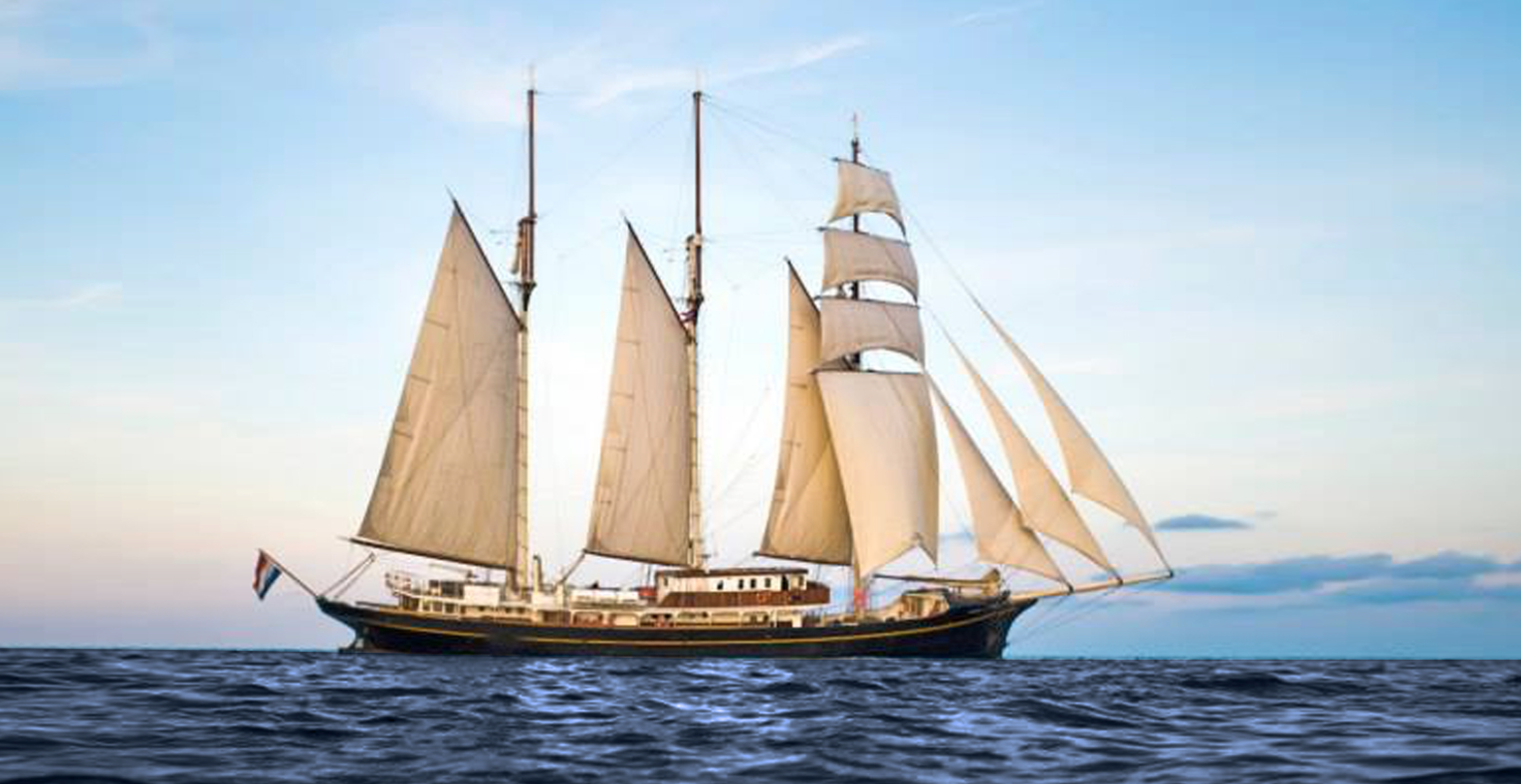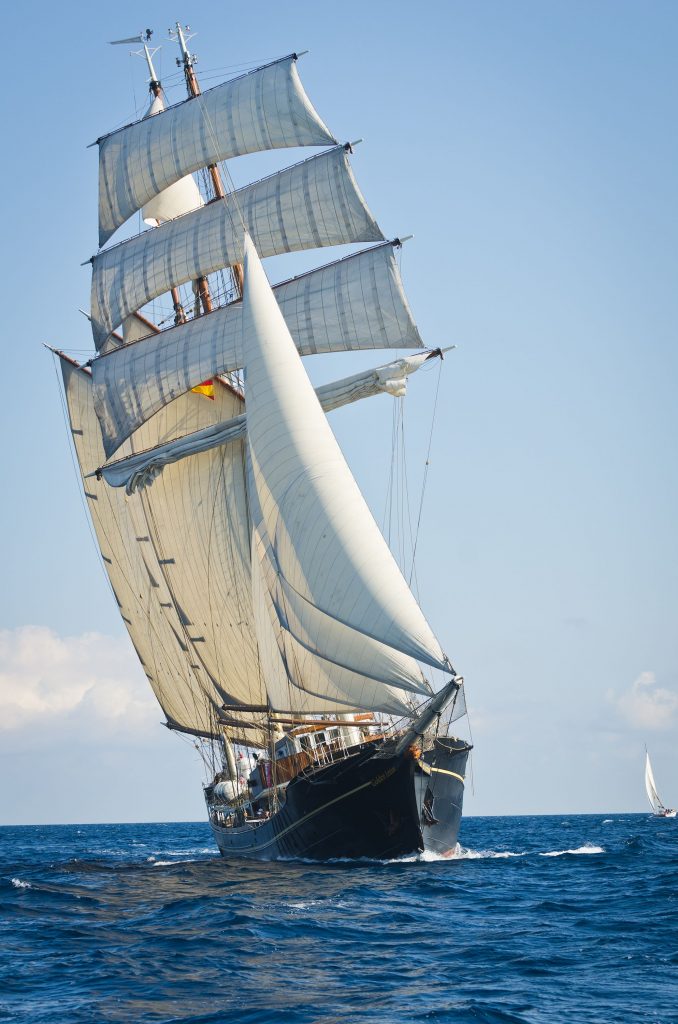
Have you ever heard of a school sailing around the world?
Between 2014 and 2018, I had the fantastic opportunity to command a Sail Training Vessel with an entire high school on board for 375 days, and a total of 27.245 Nm. Since 1990, I had dreamed to work for the program, and though for many years I sent several CVs, but never imagined that one day I would become captain at Class Afloat.
When the subject comes up during conversation, the curiosity and questions surrounding the concept are typically the following:
What kind of school is this?
The multinational crew consists of 50-60 teenaged trainees, 10 maritime crew, 7 academic staff, a school director, and a Medical Officer. The number of young trainees, aged between 15-18 years old, varies within the program as it can be challenging for them to stay away from home for such a long period. They often feel excited to get on board, then realise just how much work is actually involved! The academic year is divided into two semesters, and a minority of trainees only sign on for a single term. There are a number of rules to comply with on board, and unfortunately some trainees were caught smoking or drinking, so these students had to be sent home. The spaces are in such high demand, there is a waiting list to fill the free bunks! Not only do the parents sign a contract, but the students need to demonstrate their motivation before being accepted for the program.
There are three academic levels of trainees living onboard: students in their final years of high school, those going into their first year of university, and then the gap year students who follow a tailor-made program as university preparation. The tailor-made program is run by West Island International College, and it even results in an academic degree recognised by the Canadian Ministry of Education. Class Afloat is therefore not a program for problematic kids, military programs, or holidays; the trainees are truly at school!
How long are the kids on board?
Class Afloat has chartered several ships since 1984. The vessel I sailed on is called Gulden Leeuw, normally departing from Amsterdam at the beginning of September for a period of nine months. For the trainees and teachers, the ship becomes their home this entire time. Maritime crew work on rotation, or per contract, depending on their role onboard. Four Captains sail the vessel in rotation for periods of six to eight weeks in order to stay fresh and keep a sharp overall view.
The vessel sails around 22.000 Nm. and touches over twenty ports, with no more than three to five days spent in each port. While in port, students participate in socially-oriented projects such as painting houses in the Dominican Republic, spending the day with orphans in Senegal, and other similar initiatives. Normally, on other days there are cultural or sport activities, with free time allowed to venture out in groups of at least four trainees.
To sail a Tallship, there are a breadth of aspects which need to be attended to 24/7. For this, the trainee community is divided into six different watches which rotate in the 24-hour period. It’s a quite complex process organising the attending of the deck, carrying out the classes, overseeing maintenance, attending the galley, and finally planning and scheduling crew, teachers and trainees. And then comes the captain (or “Officer of the Watch”) in the middle of all of this with an announcement, “All crew, all crew, this is your captain speaking, all hands on deck, all hands on deck, captain speaking, out!” These all hands or idle hands calls are made when a squall is coming, for example. In my early days, I was once advised by the school director: “Hey Captain, could you please not make an all hands calls every time you see a whale?!”
As the program constitutes sailing around the world with most of the time spent out at sea, teenagers and parents are not able to meet often. Only three times in the entire nine months are “Parent ports” scheduled, where parents travel to the next port of call to meet their children. Not all of the parents can afford to travel so far, so the crew spends some fun time together with “our orphans”.


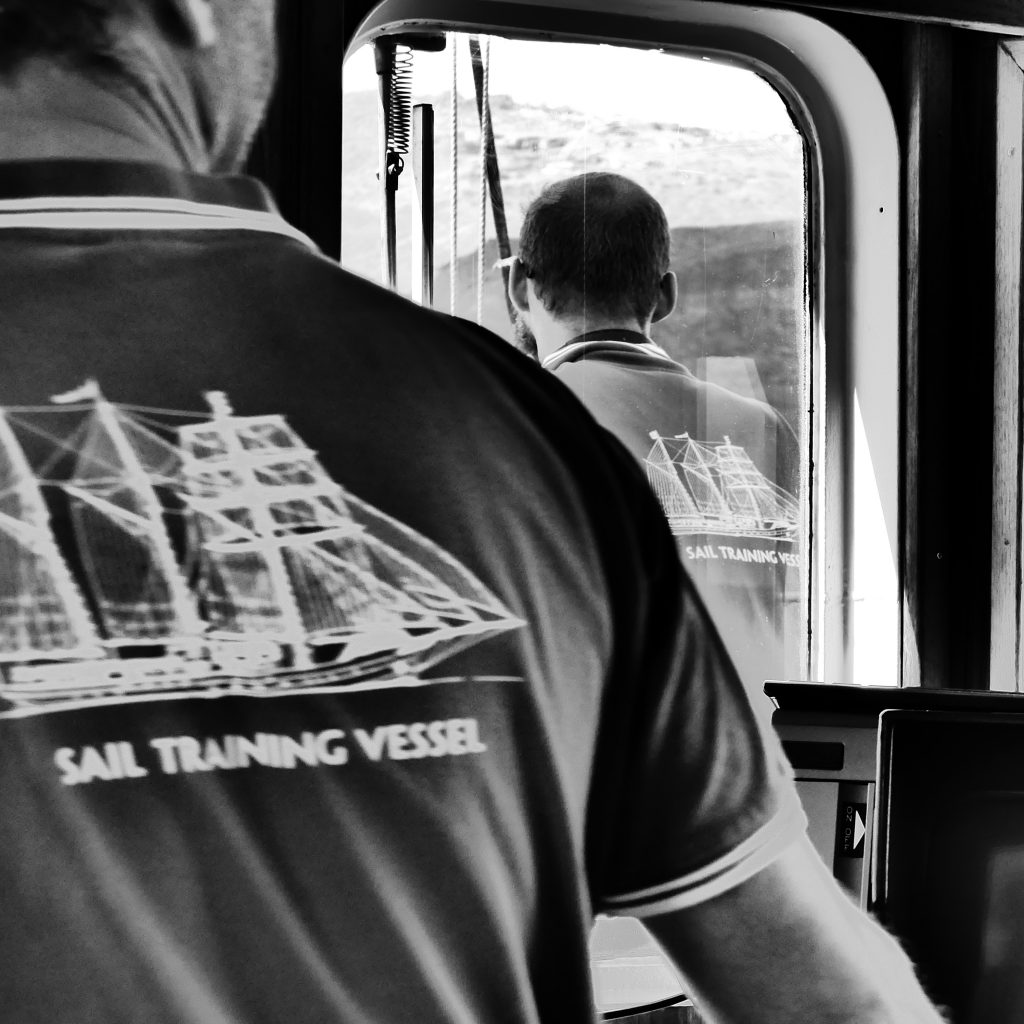
How big is the boat?
The three-masted top-sail schooner has a length-over-spars of seventy meters. It carries 11 to 13 sails under full sail, depending on whether we set the two topmast staysails. To set up these staysails, assistance is required from crew aloft while being hoisted from the deck up.
Traditional sailing and maritime traditions are highly respected on board. Though we have an autopilot option and electric winches, these are rarely used. The helm is manned 24 hours per day, in every weather condition. Such responsibility is taken very seriously as there is no wind indicator to guide help on where the wind comes from. Of course, it can be risky leaving a vessel of this size under full sail in the hands of a teenager, however we have seen trainees who turned out to be extremely good helmsmen. From the bridge, we watch the course steered (HDG & COG) and the track-line on the plotter to judge the precision of the steering. I remember one instance where I saw not even one kink in the track-line, so I assumed something was wrong with the equipment. I went outside to check and decided to take over the helm to see for myself, and it was perfectly aligned on the plotter. Perfect steering by the young Japanese trainee, called Joshi, who was called Mr. Joshi after that!
For the crew amongst you reading this, it may be interesting to note that nowadays sail training vessels are a bit out of the league, as very few of them are able to comply to with the full SOLAS passenger vessel regulations. However, they still sail with more than 36 people on board, with unlimited sailing area classifications. The main reason is due to the availability of lifeboats, which are replaced by a fast rescue boat and have 300% life raft capacity. These vessels are normally certified as a special purpose vessel or a historical vessel, depending on the flag state. Nearly everything on board is run through full ISM, and equipment needs to be Classified and SOLAS approved, which ends up being a paper shop like on a cruise ship.
Why did you want to sail this boat?
This question was first posed to me by one of the parents who wanted to understand why on earth I would take on such a responsibility to sail with a bunch of teenagers, instead of being the captain on a mega yacht. I must admit, at the time I was not prepared to answer the question immediately. I have, and still am, freelancing on superyachts for deliveries or relief positions and so I understand the reason for the question. Firstly, the main reason is the social aspect (or social experiment, as I like to say), of living aboard such a “small” vessel with a community of 70 or 80 people, sailing around remote locations of the world. For as much hard work, considerable responsibility, and risks involved with such a job, the most rewarding part is seeing the trainees grow as individuals, as well as becoming competent crew.
The personal growth of the trainees after nine months is absolutely life-changing. What triggers this personal expansion is learning the meaning of responsibility, taking ownership, and experiencing how to live together with people from other backgrounds or cultures.
Also, to see them grow from total greenies to proper sailors is also very satisfying. The maritime crew is constantly being challenged by constantly supervising and teaching all they know and more. In the first month, everything is very hectic, and one cannot sail the ship under full sail as the use of every sail, sheet or block needs to be explained before sail maneuvers are even possible. After four or five months, you begin having a working crew and suddenly you have sixty deckhands! But in the last three months it starts to become really fun, and you can talk every maneuver through. “Hey, watch leader…you’re not able to properly clew-up the starboard side of the upper topsail because it seems that one of your buntlines is caught somewhere.” That is all that needs to be said to hear a 16-year-old watch leader shout down to the lower deck; “HEY Jeremy, put on a harness and go aloft, check the blocks at the upper topsail yard going to starboard, especially the far most outer buntline. The rest of the watch standby on the pin-rail, ready to ease starboard bunt-lines on my command.” Then when you hear the crew repeat the exact command of the watch leader; you know you have a crew. It’s beautiful! By the time the final months arrive, you barely need to tell them anything…unless it’s “Guys, please, I am still in charge here, can you please ask me first!”
Finally, I love the fact that Class Afloat sails off the beaten track. Because of my experience in the program, I have visited many countries in South America, dropped anchor in the San Blas Islands, dove in Fernando de Noronha and St. Helena, and will never forget Ascension Island.
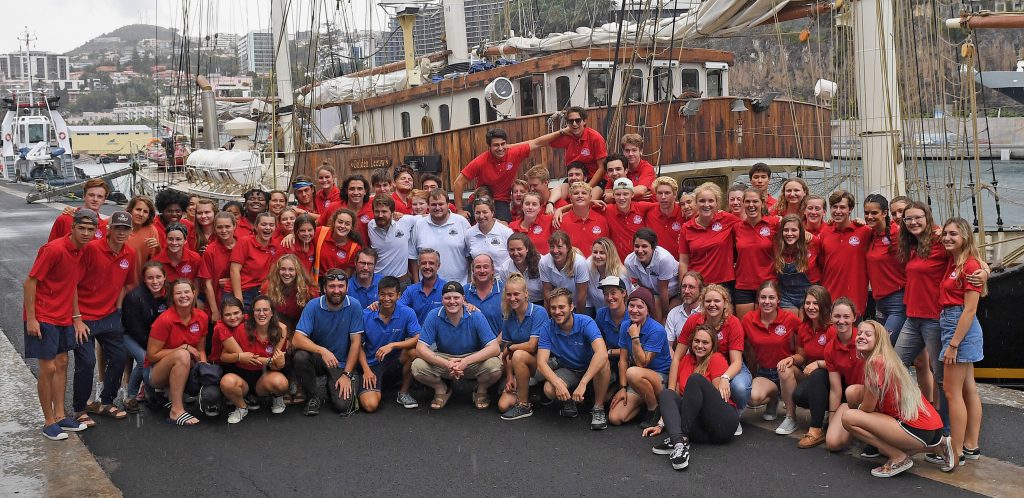
Last but not least, the most common question is: did you ever have to sail in a storm?
Sure, we had bad weather and storms, but for some reason I never liked this question. There is nothing fun about it, and it is simply part of sailing offshore. Sails are reduced and the crew puts on theirs foulies and safety harnesses. Everything on deck and below deck needs to be secured and lashed down, and all hatches, doors and portholes closed etc. There is an entire checklist for this! We barely sleep, and go into conservative safety mode, checking and double checking everything that could go wrong or break. One thing is for sure: that you really get to know your crew during bad weather conditions, as being under duress really brings out their real attitude, and tests what they really know.
But the moments I look back on with the most fondness were when the dolphins and whales surrounded the boat, when a rainbow showed us the course to steer, and the crew sang shanties in the background. The equator crossing is a big one, where any crew who had never crossed it before will have to be judged by Neptune before becoming a Shellback. Birthdays are celebrated with a bucket of water, and if we like you a lot, you might have the privilege of being drenched with the fire hoses to make sure you have a good beginning of your day. That is something, not the storms!
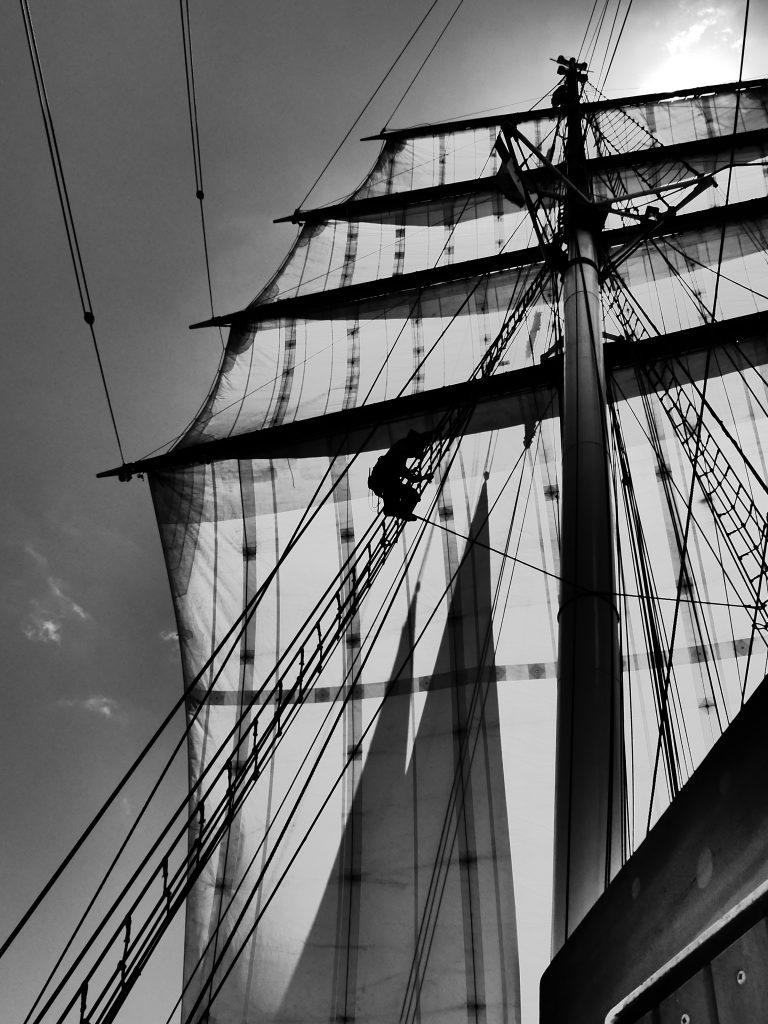

I could write a whole bunch of articles about these years with Class Afloat, as you can imagine. I will have to sit with The Islander Magazine though, or perhaps write a book one day!
I hope this motivated you sailors to go out there and sail the Oceans singing shanties with a Tricorn Hat.
Fair winds,
Capt. Dominique Geysen
Feel free to share at your convenience, and don’t hesitate to reach out if you would like to know more about the program.

